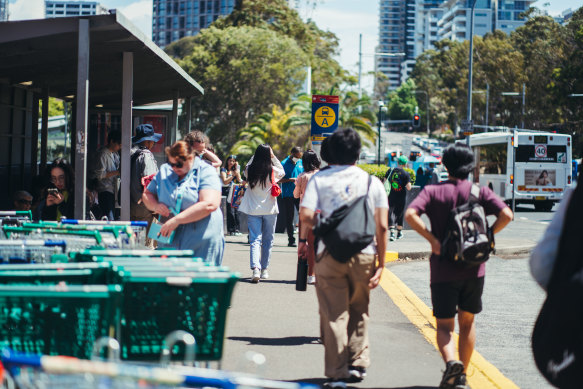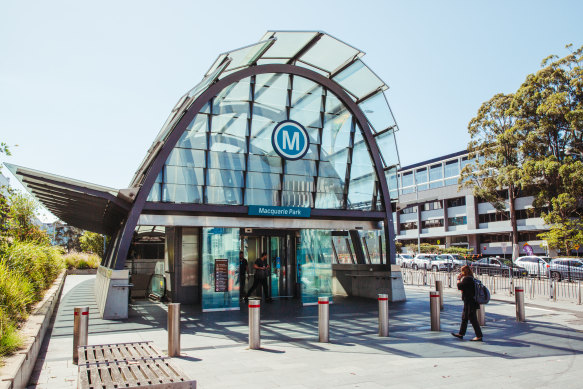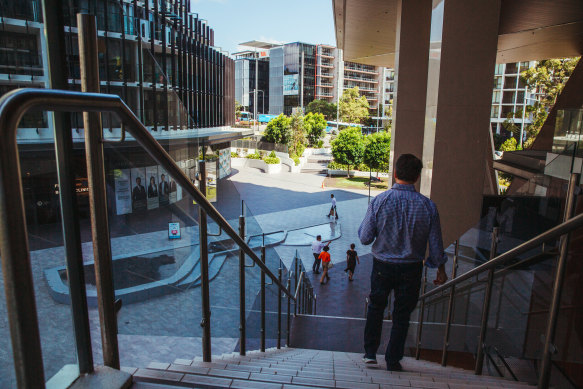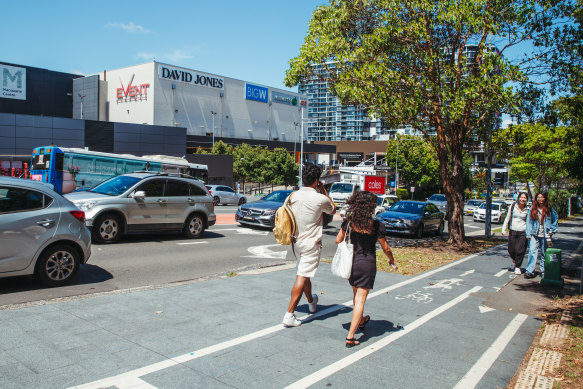This was published 1 year ago
It’s a thriving business hub. Now it’s rezoned for housing. Can this Sydney suburb really take both?

Macquarie Park.Credit: Dion Georgopoulos
The news
The state government announced it will change planning controls in Macquarie Park, one of Sydney’s major business districts, to allow about 5000 build-to-rent apartments on land currently zoned for commercial use, and an extra 3000 units on three sites that will be zoned for mixed-use.
Ryde Council has baulked at the intervention, wishing to preserve the land for employment and commercial uses, and arguing there are already up to 20,000 apartments coming down the pipeline nearby.
Premier Chris Minns suggested there will be more forced rezonings like this across Sydney as the government looks for ways to increase housing supply. So how would it apply in Macquarie Park?
How we got here
The NSW government is on a crusade to build 377,000 new homes in five years, not only because they are needed but because national cabinet has compelled the state to do so.
On paper, Macquarie Park seems like an ideal location for a share of those dwellings. It has two metro stations on the Waterloo Road corridor, and a third, North Ryde, at the eastern end of the precinct. It also boasts a high-tech business hub brimming with good jobs, a large shopping centre and a well-regarded university.
Minns wants to encourage this by allowing build-to-rent units, as well as commercial development, in the main stretch of the business park on either side of Waterloo Road.
The premier says this is partly due to market conditions: demand for commercial office space has declined since the pandemic began, while the need for housing has increased. Flexible, mixed-use zoning is seen as best practice.
The proposed changes also involve allowing taller buildings - providing certain conditions are met - up to 190 metres (60 storeys) on some sites.
Combined with development proposals that are already in various stages of the pipeline, Macquarie Park would be transformed from predominantly a business park to a mixed-use innovation and residential precinct. Ryde Council estimates the population would soar to more than 100,000.
Key players
The project is being driven by the new Labor state government, although the previous Coalition government had already effected a “place strategy” for Macquarie Park, recognising its strategic importance along the metro line.
Ryde Council, headed by Liberal mayor Sarkis Yedelian, is leading the charge against the changes, saying building more housing than planned would place a higher burden on already strained infrastructure. That primarily means roads and traffic, but there are also concerns about a lack of schools.
The Macquarie Park business community is another key stakeholder. Sydney’s second-largest business district includes companies such as Optus, Johnson & Johnson, Novartis and Fujifilm.
Macquarie University, ranked 10th in Australia, is highly connected to the surrounding innovation district, which it says has the highest number of intellectual property registrations of any postcode in Australia.
Vice-chancellor Bruce Dowton said the university acknowledged the state’s pressing need for more housing. “However, the university is concerned that the proposal expansion of residential development inside such a successful and longstanding innovation district will erode its fundamental purpose.
“It is critical to ensure that future development does not diminish the significant role the precinct plays in our economy and community,” he said.

The Macquarie Park Metro station, which will soon be connected directly with the North Sydney and Sydney CBDs.Credit: Dion Georgopoulos
What they said
Premier Chris Minns: “For too long, there’s been an understandable desire to build commercial and industrial space in Sydney, neglecting the need for new homes. Wherever we can get mixed use communities, that’s exactly what we’ll do.”
Mayor Sarkis Yedelian: “Ryde is already providing and approving enough housing in the Macquarie Park Innovation District that is way above our state-mandated quotas. It should be noted that once commercial space is gone, it’s gone for good.”
Planning Department secretary Kiersten Fishburn: “If the commercial market suddenly takes off again, and that becomes the most viable for a developer or an asset owner, it is much, much easier for them to transition their build-to-rent to a commercial build than it is to transition a strata apartment. And you can still build commercial.”
Ryde Liberal MP Jordan Lane: “This plan was never even mentioned pre-election. While I understand new governments want to put their stamp on things, it’s important to be upfront with communities if you want to earn their trust.”
By the numbers
11,071: Residents living in Macquarie Park at the 2021 census. They skew young with a median age of 31.
20,000: New apartments in the pipeline, either under construction, concept approved or awaiting approval.
$770: Median weekly rent for a two-bedroom apartment in Macquarie Park.
Three: Metro stations (Macquarie University, Macquarie Park and North Ryde)
1.3km: Distance between Macquarie University and Macquarie Park stations
72,000: Employees in the Macquarie Park innovation precinct.
44,000: Students at Macquarie University, plus about 3000 staff.
$9.5 billion: The precinct’s economic contribution to NSW in 2018.
What you need to know
According to Ryde Council, there are already 23 large developments in train in Macquarie Park which would supply more than 20,000 apartments. For example, Harry Triguboff’s Meriton is building its Trilogy project of three towers - the tallest being 58 storeys - on Talavera Road.

The Macquarie Park CBD.Credit: Dion Georgopoulos
Then there is the $2.2 billion redevelopment of the Ivanhoe social housing estate, with 3300 units public and private, BaptistCare’s proposed vertical village of 550 units and AMP Capital’s redevelopment of Macquarie Centre, with towers up to 37 storeys, which has concept approval.
There are also three build-to-rent housing projects already underway in the E2 commercial zone along Waterloo Road, for a total of 2529 units. The new units enabled by the state government’s proposed changes are on land zoned as E3 (productivity support).
In March, industry news site The Urban Developer described Macquarie Park as a “hotbed for developers and planners”.
The battle for schools
The government will build a new primary school, Midtown Macquarie Park, for up to 750 students on the site of the old Ivanhoe Estate. The department notes the area’s primary school student projections are forecast to triple by 2041.
There is also supposed to be a new education campus nearby at Lachlan’s Line, close to North Ryde metro station. It would comprise a primary school for 1000 students and a high school for 2000, due for completion by 2026.
Labor was sceptical about that school because it is to be delivered as part of a “mixed-use development in partnership with the private sector”. But the campus is still part of the updated infrastructure delivery plan prepared for the Department of Planning, dated October 6.
However, state Liberal MP for Ryde Jordan Lane says those schools are based on the previous population projections, and if the government wants to add another 8000 homes, an extra school is required.
“There’s no funding for that, there’s no site for that. They’re just hoping everybody will cop it,” Lane says. “That’s where you start to lose public confidence [in growth].”
Traffic woes
Yedelian, the Liberal mayor, said the council was not consulted about the rezoning. “It was a surprise,” he said. His chief worry is about traffic; despite the Metro being operational since 2019, he says traffic is currently “chaos” in peak times.

Traffic concerns dominate opposition to the rezoning.Credit: Dion Georgopoulos
A detailed study by Transport for NSW, completed in September 2023, shows congestion is an issue, though not everywhere. It models two scenarios to 2041: doing the minimum, or implementing all transport and place-making initiatives in the Strategic Infrastructure and Services Assessment.
The model finds Lane Cove Road will remain congested in either case, but Herring Road, Waterloo Road and Delhi Road will still be below capacity. Even with all recommendations implemented, delays in the precinct are expected to increase by 25 per cent to 128 seconds per kilometre by 2041.
What’s next?
The state government is running the ruler over Metro stations existing and forthcoming for opportunities to ramp up housing density. The Herald has reported Bella Vista, Kellyville, Crows Nest, Sydenham and Bankstown are all of particular interest.
The other key factor for build-to-rent developments will be federal taxation. Developers and industry bodies are campaigning against proposed changes to thin capitalisation rules they say will put up to 150,000 BTR homes at risk.
The build-to-rent sector already struggles in Sydney compared to Melbourne due to land prices, although that is starting to turn around.
Further reading
Rich kids playground: What’s holding back build to rent in Sydney
Plan to fit 3000 homes between two metro stations in northern Sydney revealed
New Sydney public schools to share space with shops, apartments under radical proposal
Start the day with a summary of the day’s most important and interesting stories, analysis and insights. Sign up for our Morning Edition newsletter.